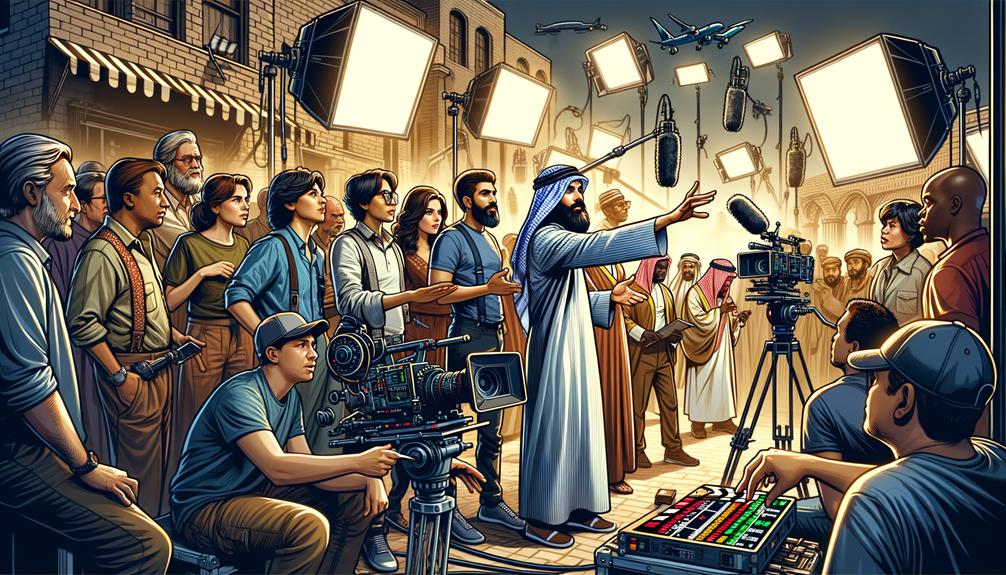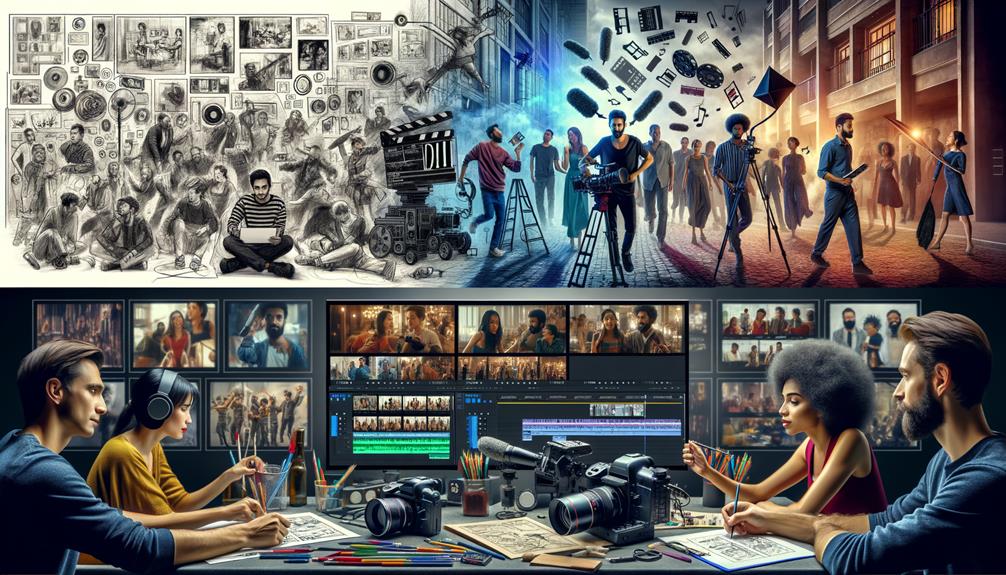As dawn breaks over a bustling film set, I find myself reflecting on the intricate journey of video production, a path I’ve navigated countless times. This process, from the initial spark of an idea to the final edits, is a delicate balance of creativity and precision.
In my career, I’ve discovered that understanding the nuances of each stage – pre-production, production, and post-production – is crucial for crafting impactful content. Yet, there’s more to this story, a depth that goes beyond the surface of these stages.
Let’s explore together the challenges and triumphs that define this captivating world, where art meets execution.
Key Takeaways
- The video production process encompasses strategy and planning, production execution, post-production work, and a distribution strategy.
- Success in video production requires collaboration, creativity, and meticulous attention to each stage of the process.
- Effective communication and coordination among team members are crucial for a seamless workflow from start to finish.
- Setting clear goals, understanding the target audience, and continuously monitoring and adjusting strategies are key for impactful video content.
Strategy and Development

Defining the video’s goals, messaging, and key performance indicators (KPIs) marks the initial and crucial step in the strategy and development phase of video production. This stage is foundational, ensuring that my team and I align our objectives, understand the video strategy, and set clear KPIs. It’s about laying down a concrete framework that guides the entire planning process.
Pre-Production Planning
In pre-production planning, I focus on setting clear goals, defining our budget, and meticulously developing scripts and storyboards to ensure a solid foundation for our video project. This phase is pivotal for aligning our vision and preparing for the challenges ahead.
Key steps include:
- Identifying Production Deliverables: What’re we aiming to produce? This guides every decision.
- Storyboarding: Visualizing scenes ensures clarity and coherence for the team.
- Casting and Location Scouting: Finding the right faces and places to bring our story to life.
- Scheduling: Crafting a production schedule that’s realistic and efficient, setting milestones for every stage of the pre-production phase.
This strategic approach in pre-production planning sets the stage for a smoother production process, ensuring we’re prepared to create something truly innovative.
Production Execution

Transitioning into the production phase, we meticulously set up our sound and lighting equipment to ensure every frame of footage is captured with the highest quality. This phase involves a rigorous process where my video production team and I dive into the heart of our project.
Coordinating with talent becomes a daily routine, ensuring that everyone is on the same page and ready for their moment in front of the camera. Our skilled camera operators play a pivotal role, capturing the essence of our script with precision and creativity.
Adhering to the production schedule is key; it’s the roadmap that guides us through each day, ensuring every scene is shot and every interview is conducted within our tight timelines. This strategic approach keeps our production on track and brimming with innovation.
Post-Production Work
After capturing every scene with meticulous care during the production phase, I now focus on the post-production work, where the raw footage transforms into a polished final product. This phase is where creativity meets technology, and I ensure every detail aligns with the envisioned outcome. Here’s how I approach it:
- Video Editing: Cutting and assembling the footage to narrate the story smoothly.
- Sound Elements: Mixing voiceovers, background music, and sound effects to enhance the auditory experience.
- Graphics and Animations: Adding visual flair that complements the narrative and engages the audience.
- Color Correction: Ensuring visual consistency and mood by adjusting hues and saturation.
These final touches bring the project to life, readying it for the eager eyes of our audience.
Distribution Strategy

Crafting a well-thought-out distribution strategy is crucial for ensuring my video reaches its intended audience effectively and efficiently. As part of a video production company, I’ve learned that understanding my target audience and choosing the right platforms are key. Here’s how I approach this:
| Stage | Action | Purpose |
|---|---|---|
| Research | Analyze past performance | Refine strategy |
| Selection | Choose platforms | Match audience demographics |
| Testing | Utilize multivariate tests | Optimize engagement |
| Promotion | Collaborate with influencers | Increase visibility |
| Analysis | Monitor & adjust | Improve future strategies |
Frequently Asked Questions
What Are the 4 Stages of Video Production?
Again, its Pre-Production, Production, Post-Production, and Marketing & Distribution. Each phase plays a pivotal role in transforming creative ideas into impactful visual content that resonates with audiences.
What Are the Steps Involved in Video Production?
I’m tackling the steps involved in video production, focusing on planning, organizing, filming, and editing. These steps ensure my content communicates effectively, engages my audience, and stands out in a world craving innovative storytelling.
Conclusion
Crafting a video from initial concept to viewer screens is a journey of transformation. In strategizing and developing, I lay the foundation, imagining the endless possibilities.
Pre-production planning sharpens these ideas into a clear vision, setting the stage for what’s to come. Execution during production breathes life into our collective dreams, capturing moments that speak volumes.
Post-production work sculpts these moments into a compelling narrative, while a thoughtful distribution strategy ensures our story reaches hearts far and wide. Each stage, meticulously executed, culminates in a video that not only tells a story but resonates deeply, leaving a lasting imprint on its audience.



